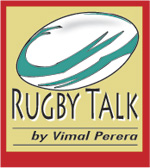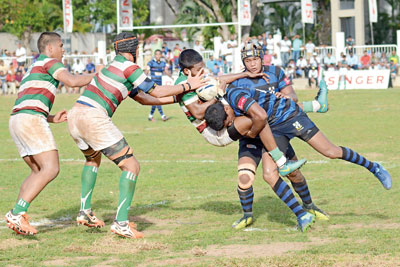Points to ponder and the law of averages
View(s): The Schools Rugby Round II details have been published. Everything will go on well until and, or unless Trinity College loses a match. This will be maddening, as the overall average will be the result of unequal numbers. That is one group will have played 10 games and the other 9 games, when the League ends. Will the arithmetical average be able to satisfy?
The Schools Rugby Round II details have been published. Everything will go on well until and, or unless Trinity College loses a match. This will be maddening, as the overall average will be the result of unequal numbers. That is one group will have played 10 games and the other 9 games, when the League ends. Will the arithmetical average be able to satisfy?An arithmetic average is the sum of a series of numbers divided by the count of that series of numbers. If you were asked to find the class average of test scores, you would simply add up all the test scores of the students, and then divide that sum by the number of students. The reason you use an arithmetic average for test scores is that, each test score is an independent event. If one student happens to perform poorly in the exam, the next student’s chances of doing poorly (or well) in the exam isn’t affected. In other words, each student’s score is independent of all the other students’ scores. Does the Schools Rugby League lend to this fit?
Why not think of a geometric average, as is done in the case of investments, where your next investment depend on what happened previously. Still, I believe this will not work. Why not work a Z-score familiar with the GCE ‘A’ Level results; more misunderstood than understood, which measures the number of deviations from the mean, giving a different ranking. At present, the Z-score is not applicable, as the 12 teams are not ranked. The problem, as I said, will be, if and when a match is lost by a Group ‘B’ team. Even as at present, if a Z-score is worked, Isipathana College may find themselves ranked higher. Another may be, taking 5.5 points off all teams in Group ‘A’. Then the arithmetical average will drop to 4.5, from the present 4.6. I believe, the Z-score will still remain the same. I am no mathematician and am subject to correction. What I am trying to show is the absurdity, when a school forces itself to make the groups unequal, but still carry on for the sake of a tournament.
This shows how unequal numbers affect the result. Fortunately, we don’t rank from 2 Groups as it is, but then, we will have to look at the distortion the unequal numbers make as the real average is not representative. Why did not the Schools section fight their case to an end, as the tournament affects not 25 children from one school, but 24 times 25 players in each school, which works out to 600 players. On the other hand, my recollection is that, when one State organisation has a legal issue, they have to seek the intervention of the Attorney General’s Dept. If this was not done, why did the Ministry of Education allow this to be solved this way, without sorting out the issue of filing a case without following protocol?

The first round of the Singer Schools Rugby League Division I had interesting outcomes, that the second round of the competition is expected to provide more thrills and frills - File pic by M.D. Nissanka
The advent of DS Senanayake College (DSS) to the League was a result of the School Section wanting the tournament go on without a stop, as DSS has initiated action for a place in Division I, while challenging the inclusion of Prince of Wales College. Reminiscent of the way the country is moving, the Schools Rugby section did not want a face-to-face, but decided to take what was thought the easy way out. The proposed battle was more on emotion than a rational decision based on Rugby capability, taken to substantiate inclusion. While the game may suffer and schoolboy’s life played DSS will get the ‘Singer’ sponsorship of Rs 750,000, as against Rs 500,000, if they were in the lower Division. Every team in the Schools League gets an amount from the Sponsor, scaled down, depending on the Division they play. The total paid to all schools is expected to be over Rs 20 million. The irony, however, is that, the total spent on all schools is almost equal to or less than what one ‘A’ Division school spends.
What DSS players faced in continuing in ‘A’ Division is known. It was a case of schoolboys being taken to slaughter, week in week out. Is there any chance of this being categorised as child abuse? They were no match to other schools in their segment, and were like chalk and cheese in comparison. The overall points against DSS were a staggering 323 points, while POW had 154 points scored against them. At this point, we can be pedantic in the argument and say that DSS played against 6 teams. Take the average, which is the focal point for deciding the ranking, and DSS would still be high in conceding most points. DSS will now play ion the Plate Segment, taking with them an average of 1 point, the same as POW for points accumulated on the basis of 1 point for each match played divided, to arrive at the average.
On the other hand, take the case of Kingswood College which was invited at the last minute to take a place in the top Division, so as to balance numbers. They said, “No, thank you”, and played in the lower Division, and have not lost a match so far, and have staggering points scored for. They now have a sound chance to be Plate winners and move to the top Division next tear. The morale of the players is high, as they beat all within their standard and can rightly claim to be in the top Division next year.
In the Plate, DSS now stand below St. Anthony’s, Dharmaraja and Science College, who have 1 win against a side in their Group, who are in the Plate. Kingswood would carry a maximum of 5.5 points. Division II was also made unbalanced as DSS’ place was not filled, and only 1 team, Lumbini College entered the Plate with a handicap. That is, they have no team they have played against and will probably carry a gratis of 5 points. They will take 5th place, ahead of DSS, who will probably fall to 7.
DSS would probably have been better off playing in Division II and the boys would have played within their capabilities, and had a better morale. As it is, they go with a broken spirit, which is not easy to recover. The emotion driven action probably supported by legal points, cannot replace the damage that has been done to a set of schoolboys whose history in Rugby is one they will want to forget. Not only this team, it will also affect the team that may play next year.
It is not only the Plate that is in disorder, but the Cup too, as a tiny average difference can light a spark. Well and good if Trinity wins all its matches in the next Round. The average will not see an issue and winners of the League will be Trinity who, so far, have shown they deserve a win, considering that, they have scored 45 tries, which is what the spectators want to see. Next are Isipathana and St. Joseph’s College, who have scored 35 tries each. The Joes had a huge number of tries added from their last game against distortion creator DSS. The effect on the points is not seen at the moment, as there will be bonus points for a maximum of 4 tries. However, when the overall places are counted and there is a tie at any stage, then the tries scored will count. Schools that played DSS have an edge, though it may be small in decimals.
Vimal Perera is a former Rugby Referee, coach and Accredited Referees Evaluator IRB


